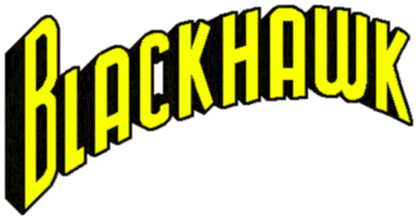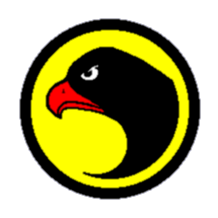

In an interview with Cat Yronwode printed in Blackhawk #260, July 1983, Eisner described the Blackhawks' creation:
"In the case of the Blackhawks, the war was on already in Europe. Germany seemed invincible at the time. This was adventure. The Blackhawks represented to me, a super-guerrilla group. I liked the idea of a group having an island of its own, outcasts from every nation. I had a fascination with the Foreign Legion then. Today, that idea doesn't mean much. But for me, at the time, it had the same strange fascination that the Wild West has for Europeans. Everybody had a gun and was his own law. And men would band together and form gangs. It was the gang idea, guys belonging to a kind of private society."
"He chuckles. 'I read a lot of pulp adventures when I was younger,' he admits.
"Eisner not only came up with the concept of the Blackhawks, he designed their costumes, named the characters and selected the type of airplane they flew. In all of this, however, he openly acknowledges the help of his fellow artists in the shop, particularly Bob Powell and Chuck Cuidera. For instance, in the matter of names, Powell had a big influence. Of Polish extraction, his real name was Stanislaus Pulowski. As Eisner explains, 'We were trying to put together a whole group of guys from different countries. That followed a traditional, time-honored pattern, which came from the pulps. If you go back to the stories of the French Foreign Legion, you'll see that they always had guys whose names represented their countries. They generally were popular names. So I turned to Bob and said, 'Hey, you're Polish. What's a good Polish name?' And of course, he said, 'Stanislaus'!'
"As for the origin of Andre, Eisner offers the suggestion that the name was chosen 'because it was a good French name. I knew that because I knew that Andre Le Blanc (a fellow artist, then working for Fiction House Comics) had a French background.'
"Chop-Chop seems to have been Chuck Cuidera's contribution. 'I decided to have a Chinese cook,' says Eisner, 'and Chuck said, 'How about calling him Chop-Chop?' In fact, the entire idea might have been his. Chuck was a feisty kind of guy. he would suddenly stand up and walk over as though he was going to quit or make a big proposition. He would have thought something out, and he would propose it with a great deal of seriousness. I'd say, 'What exactly do you have in mind, Chuck?' and he would say very earnestly, 'Well, I think we out to have THAT in the next story!' So I would respond with great seriousness and say, 'Yeah, I think that's a good idea. Let's do that.' He had good ideas, but he really had to work himself up before he would present them. I know I designed all the characters, but Chop-Chop may have been Chuck's idea in large part." [DLT's note: See "Chop-Chop to Wu Cheng: The Evolution of the Chinese Character in Blackhawk Comic Books" for an academic analysis of ethnic sterotyping and its evolution over the decades of Blackhawk's publication.]
"The matter of the planes the Blackhawks flew is another area in which Eisner acknowledges Bob Powell's contribution. 'There was a kind of friendliness, a kind of workshop or team atmosphere in the studio back then,' Eisner explains. 'I think everyone there wanted to identify himself or his work somehow. Remember, no one was getting much individual attention at the time. Not every feature carried a credit line. Nobody was getting much personal exposure. So anyway, this feature was created in the shop. At the time I generally talked out the idea for a new feature with the guys in the shop. I would talk it out much the way a baseball manager or coach would . . . 'Okay, here's the strategy, here's what we're going to do, here's the feature, here's the kind of character.' And out of this process, we developed the ideas. Now Bob Powell was hung up on planes. He ultimately joined the Air Force, as a matter of fact (in World War II). So we came up with the idea of using a certain model Grumman airplane, which had a very strange configuration. It had tailfins coming out from under a wing. It also apparently had the capacity to make a rapid takeoff from the deck of an aircraft carrier. It was a Navy plane, as I remember, not an Army Air Force plane. Actually, in real life, it turned out not to be as good a plane as everybody thought it would be, but it sure looked sexy!' [DLT's note: obviously the (false) idea that the F5F Skyrocket really wasn't a good plane was planted early, so maybe I shouldn't be so hard on Howard Chaykin for his similar assumption. No, he should have done the research.]
"Eisner was what his fellow cartoonists called 'an idea man.' He would create a new feature, design costumes and props, write and lay out the first few episodes, and then turn the story-line over to a team of writers and artists who would continue to produce it under his editorial direction. Blackhawk was no exception to this rule. 'I drew the first cover, as I remember, and wrote the story. Chuck Cuidera drew it, with great attention and singleness of mind, and used tons of white paint,' says Eisner, laughing. 'Just caked over with white paint . . . but he was good. Anyway, I don't think I wrote - fully scripted - more than the first ten stories. After that I edited it, supervised, made changes, revised it as needed. the next writer was a fellow who did a lot of work for us, a man named Dick French, who was (artist) Tex Blaisdell's brother-in-law. He did a lot of Blackhawk stories, and other things as well. He also wrote the Blackhawk songs. He was musically inclined. I think he could also write music."
" 'We then bought freelance stories from all kinds of people. There was one fellow whose name I forget. His head was shaved clean. I always thought he was Russian. He had what sounded like a Russian accent, a bullet head, totally shaved, and he graduated from N.Y.U. I don't remember his name, but I could draw you a picture of him. He looked like Khruschev, sort of a jolly Khruschev. Then one day I discovered that he wasn't a Russian at all, and the reason he had this strange accent was the fact that he was not only deaf, he was also mute, and he had just simply taught himself to how to speak. He'd come up and deliver this stuff. I remember his scripts were very, very good. Good strong writing.'
"Because Eisner has always, to this very day, written his scripts directly on the art boards, he sometimes found it difficult to deal with writers who turned in their assignments in more conventional form. The 'Russian' and Dick French were some of the first writers Eisner dealt with who did not supply their stories in the form of rough layouts. 'Around this time, I was getting used to dealing with typewritten scripts. I still hate typewritten scripts - I find them hard to work with. But the boys in the shop were getting used to them. They didn't mind then. Now in those days, in my shop at least, now script was written in concrete. Anybody who wanted to change a script had a right to do it. If the penciller or inker (they were usually the same guy) came up with something better, they could just change the dialogue. that's how we did it in my shop; everybody had a hand in it.'
"Letterer Sam Rosen completed the original creative team on Blackhawk. In time he was replaced by Martin DeMuth, whose distinctive banner-shaped captions contributed to the look of the entire Quality Comics line. Reed Crandall then took on the art chores, although by this time Eisner had been drafted. 'As I remember, by the time Reed Crandall got there, I was in the Army. The whole shop in Tudor City (a part of Manhattan) had to be closed down and moved to Stamford, Connecticut. Busy Arnold then monitored both my books (including The Spirit) and his books, as well as the books we did together. Reed Crandall had come over from Jerry Iger's shop (which produced work for Fiction House Comics). You see, Iger and I had made an agreement that for two years after we broke up our partnership (in late 1939), we would not raid each other's shops for talent. I couldn't deal with Reed because he was not one of the guys who was on waivers, but eventually Busy Arnold got him to come over.
" 'Dave Berg also worked on Blackhawk; I think he did back-up stories, helped with inking, things like that.'
"Eisner was in the Army throughout World War II, and when he returned, he severed his relationship with Quality Comics, preferring to concentrate on the weekly Spirit newspaper section. Although Quality did publish a comic book containing reprints of Spirit sections, Eisner never again wrote or drew a feature for Busy Arnold's company."
DLT's note: Be sure to see the Blackhawk History page to read the complete story about the creation of the Blackhawks. It didn't quite happen the way Eisner describes it here.
![]() Back to Blackhawk Creator's Page
Back to Blackhawk Creator's Page
All characters, pictures, and related indicia on these pages are the property of DC Comics. All text is ©2000 Dan Thompson, except where otherwise noted. This website is not intended to infringe on the copyright of DC Comics to its characters, but was created out of gratitude to all the wonderful writers, artists, and editors who created the Blackhawks.